We are told as children that the key to avoiding serious injury in a car accident is to wear our seat belts. It is also the law, with the Alberta Royal Canadian Mounted Police (RCMP) calling on drivers and passengers to buckle up, which can be the difference between life and death in the event of a collision.
This article looks at some of the rules and statistics relating to wearing seat belts, along with how failure to wear a seat belt may impact a personal injury claim, both for the person injured and the driver’s responsibility, where a passenger does not buckle up.
When does a seat belt need to be worn?
According to Alberta’s Vehicle Equipment Regulation, drivers and passengers must wear seat belts, subject to certain exceptions. It needs to be properly adjusted and securely fastened.
The requirement applies where the vehicle is equipped with seat belt assemblies by the manufacturer, and people are not permitted to remove them. It also applies to children six years or older or weighing more than 18 kilograms. For children who weigh 18 kilograms or less, the driver needs to secure them in a child restraint system that is properly installed.
The Vehicle Equipment Regulation contains several exceptions to the requirement to wear seat belts and use child restraints, including for:
- motor vehicles that are being used to deliver or collect items while they are being driven at a speed of 40 kilometres per hour or less;
- motor vehicles driven in a parade authorized by a municipality; and
- a person with a letter from a medical practitioner certifying that they cannot use a seat belt or child restraint due to medical reasons or physical characteristics.
In addition, child restraints are not mandated for taxis, emergency vehicles or motor vehicles rented for periods of not more than 14 consecutive days. Taxi drivers carrying a passenger, bus drivers operating a bus driven as part of a municipal transport system and ambulance attendants carrying a patient do not need seat belts.
What are the possible penalties? What do the statistics show?
Failure to wear a seat belt in compliance with the Regulation can attract a fine of $162. The statistics show that failure to wear a seat belt is a common occurrence. According to the Alberta RCMP, there were almost 4000 seatbelt-related offences in 2022.
Can you claim for personal injury if you were not wearing a seat belt?
Suppose you have been injured in a motor vehicle due to someone else’s negligence, but you were not wearing a seat belt. In that case, obtaining advice from an experienced personal injury lawyer is important. We can advise you about your prospects of succeeding in a compensation claim and the impact of not buckling up.
The courts have noted that both drivers and passengers have a duty to look out for their own safety by wearing seat belts. If they are injured in an accident and do not wear a seat belt, they will likely be found contributorily negligent.
This means that a person injured due to the fault of another person is likely to be also found partially at fault for their injuries if they were not wearing a seat belt. The amount of compensation that they are able to claim will be reduced in proportion to their degree of fault.
The Supreme Court of Canada, in the case of Galaske v O’Donnell (Galaske), said:
“The courts in this country have consistently deducted from 5 to 25 percent from claims for damages for personal injury on the grounds that the victims were contributorily negligent for not wearing their seat belts. This has been done whenever it has been demonstrated that the injuries would have been reduced if the belts had in fact been worn.”
Is the driver responsible for a passenger’s injury if the passenger fails to buckle up?
The Regulation requires Alberta drivers not to drive a motor vehicle containing:
- a child weighing 18 kilograms or less unless they are in a child restraint system; or
- a child between 6 and 16 years old or more than 18 kilograms unless they are wearing a seat belt.
Can the driver be held liable if they don’t comply with these rules when the child is injured in an accident caused by someone else’s negligence? It is certainly possible.
In the case of Galaske referred to above, an eight-year-old child was injured after the truck he was being driven in was struck by another vehicle. Neither he nor his father wore seatbelts. His father was killed, and the injured boy sued the driver.
The Supreme Court said:
“A driver taking children as passengers must accept some responsibility for the safety of those children. The driving of a motor vehicle is neither a God-given nor a constitutional right … Children, as a result of their immaturity, may be unable to properly consider and provide for their own safety. The driver must take reasonable steps to see that young passengers wear their seat belts.”
The Court found that the driver was at least partially responsible for the injuries sustained by the child, even though his father was present and also had joint responsibility for the child’s safety. The Court decided that the trial judge needed to determine the degree of responsibility of the driver, along with whether there was any negligence on the part of the plaintiff and/or his father.
Contact the Personal Injury Lawyers at Cuming & Gillespie LLP for Advice on Motor Vehicle Accident Claims
The personal injury lawyers at Cuming & Gillespie LLP in Calgary represent those that have suffered injuries or lost loved ones in motor vehicle accidents, including where failure to wear a seat belt was a factor. Please phone us at 403-571-0555 or contact us online to book a confidential appointment for a free consultation. We stand ready to support you on your journey to recovery.

